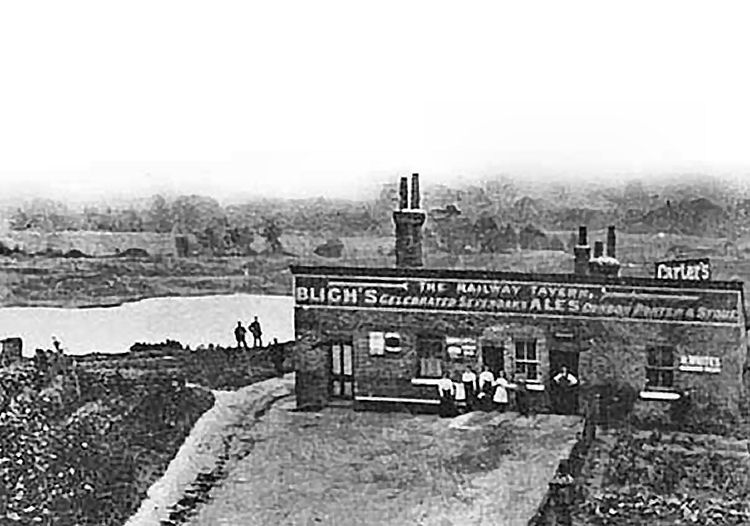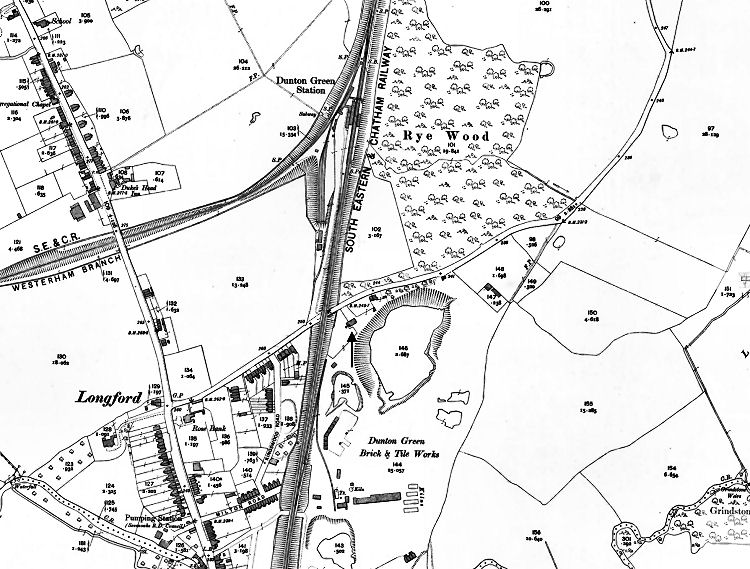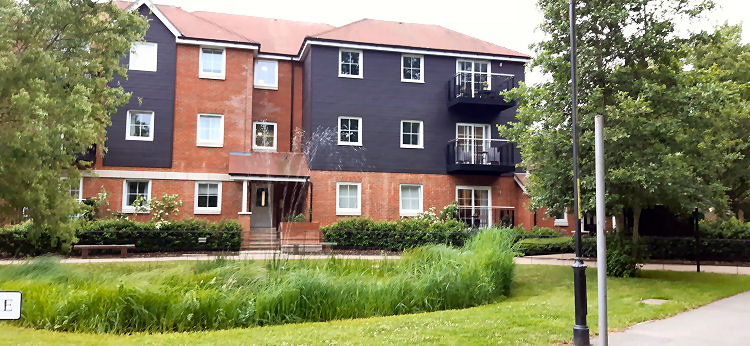|
Rye Lane
Dunton Green

Above photo circa 1900, kindly submitted by Nick Catford. |

Above map 1909. The building was in Rye Lane. By kind permission of
www.disused-stations.org.uk. |

Above photo June 2021, showing the location, kindly taken and sent by Phil Richards. |
I am informed that the building was unfortunately demolished in the mid
1970s.
The tavern stood on the south side of Rye Lane close to its junction with
the station approach road and on the east side of the railway to Sevenoaks.
The railway is on an embankment and crosses Rye Lane on a skew bridge so it
is likely the photograph was taken from this bridge or possibly from the
side of the embankment. In the left background one of the brickworks pits
can be seen, apparently flooded. Not much of any certainty is known about
the tavern. Said to have been provided for the Welsh miners employed to
excavate the nearby Polhill Tunnel, which suggests the miners encamped at
Dunton Green, the tavern likely dates from around 1862 when construction of
the railway was authorised. The figure in the doorway beneath the word
'Ales' may have been the landlord with the other people being his family or
staff. As can be seen, the tavern was supplied by Bligh's of Sevenoaks. In
1862 John Bligh purchased the former Holmesdale Brewery, situated on
Sevenoaks High Street, from John Allworth. Bligh, who is said to have been
the largest hop grower in the region at the time, enlarged the premises in
1882. He sold the brewery and its tied cottages to Messrs Watney in 1911 and
the premises were closed down in 1935. (Further
research tells me the house closed on the 28th December 1912 under the
Compensation Act.) The Bligh name on the Railway Tavern
therefore dates the photograph to pre-1911. 'London Porter' was a type of
ale made from brown malt. It fell out of favour in the years following WWII
but has made, at least in name, something of a comeback in more recent
times. The "Railway Tavern" is thought to have closed in 1935 and at some
point in time became home to a well-known local character known as 'Trigger' Turton. Turton was a lecturer of mathematics at London University (today,
the University of London) and his nickname derived from 'trigonometry', a
branch of mathematics. Turton suffered a nervous breakdown following failure
of his marriage and came to resemble a tramp, living in the increasingly
derelict and overgrown former "Railway Tavern." It is said Turton
diversified into horticulture although this may have been a polite local
joke which referred more to the way he lived than to anything else. Little
else is known about Turton but records suggest he may have been one
Frederick Turton who died in 1972. The "Railway Tavern," which came to be
known as Bridge Cottage, is thought to have been demolished in the late
1970s and its site used for an extended car park for West Kent Cold Storage.
Today the site of the former tavern lies within a modern residential
development, West Kent Cold Storage having vacated the site sometime around
the turn of the 21st century.
|
Sevenoaks Chronicle and Kentish Advertiser 21 February 1913.
INTOXICATING LIQUOR AND BILLIARD LICENSES.
Supt. Fowle's annual report of the various public houses in the
district was read as follows:-
.... The
license of the "Railway Tavern" beerhouse, Dunton Green,
expired on the 28th December, 1912, and the same has been dealt with
under the Compensation Act, 1904, compensation being paid on the 21st
December, 1912.
|
|
Kent & Sussex Courier, Friday 3 October 1913.
Distressing Motor Fatality. Dunton Green Child Killed.
A distressing motor fatality occurred at Dunton Green on Saturday
evening, a child between 2 and 3 years of
age being knocked down and killed before it's mother's eyes.
An inquest on the body was held at the "Railway Tavern" on Monday
evening by Mr. Coroner T. Buss.
Mr. Laslett Dahe was chosen foreman of the jury.
Mrs. Edith Emily Booker, wife of Mr. Alfred Booker, of Mount View,
Dunton Green, said the deceased child was
her daughter, Evelyn Gladys. She was 2 years and 9 months old, and
was a good, healthy child, her sight and
hearing being unimpaired. Witness kept a small general shop, and
whilst serving a little girl she saw the child
run across the road, apparently to another little girl who was on
the other side. Witness had never know the
deceased across the road before, and as soon as she saw her she
called out, "She has gone across the road,"
and ran from the shop, but before she could get to her the motor car
came along and knocked her down.
Deceased was about 3 feet from the kerb on the opposite side when
the car struck her. Witnessed took the child
to the Cottage Hospital at Sevenoaks but it died on the way in her
arms.
Mr. Hayley Morriss, who said he was a bill and bullion broker,
living at Blackboys, Sussex, said he was driving on
Saturday evening from Orpington, and was going towards Sevenoaks. He
got to Dunton Green at about 5
o'clock. He did not know much of the road, but had driven over it
when he went to Orpington in the morning.
He was driving at about 10 to 15 mph when he saw a child cross the
road to another child on the opposite side.
She then re-crossed without looking either way. Witnessed did not
know which side to go. Had the other child
not been standing on the pavement he would have steered straight
across, but he had done so he would
probably have run into the second child. The right side of his car
struck the child (he could not say which part),
and after the car hit her witness steered right onto the pavement
where he pulled up. He did not sound his
hooter as he had not time. There was no other traffic about at the
time as far as he knew. Witnessed took the
mother and a child to a doctor's house, but the doctor was out. They
then went to Dr. Matthews house, but he
also was out, and then went on to the Hospital, but the child, who
was alive when they left Dr. Matthews' house,
was dead before they reached the Hospital.
Dr. Alexander, of Riverhead, said he saw the body at the Cottage
Hospital. The child's neck was dislocated.
There were bruises on the right side of the head above the temple
and on the lower part of the abdomen.
Death was due to shock, following dislocation of the neck.
The Coroner:- How do you account for the dislocation of the neck?
Witness:- It is difficult to say, but deceased had had a severe blow
on the right side of the head.
The jury returned a verdict of "Accidental Death." They were
unanimous in exonerating the driver from blame,
and expressed their deepest sympathy with the relatives of the
deceased child. The foreman said they also
wished to add a rider that the jury were of opinion that it was high
time that something was done to still further
regulate the speed of mechanically driven vehicles on the highway.
Mr. de Barry Crawshay, on behalf of the motor organisation with
which he was connected, expressed deep
regret at the fatality. They did their best to prevent and alleviate
the trouble, but there were still road-hogs,
despite the traps they set to catch them. he advised the Coroner to
write to the Roads and Bridges Committee
of the Kent County Council for signs, and if they were not supplied,
the motor organisation to which he
belonged would do so for this village.
|
LICENSEE LIST
SAMUEL Thomas 1871+ (age 41 in 1871 ) )
MACEY Benjamin 1891+ (age 40 in 1891 ) )
STOVELL William 1901+ (age 56 in 1901 ) )
COOPER Albert 1911+ (age 68 in 1911 ) )
https://pubwiki.co.uk/RailwayTavern.shtml
 Census Census
|


